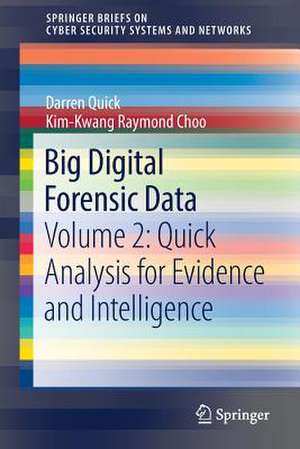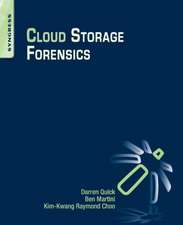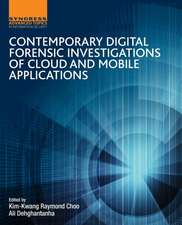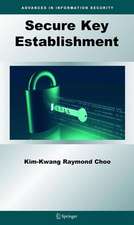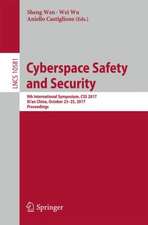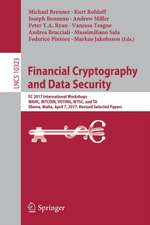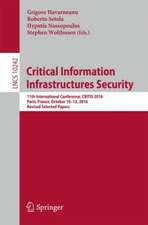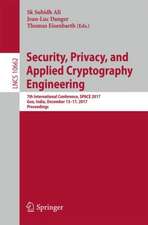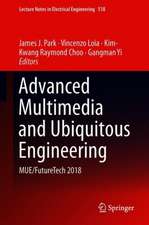Big Digital Forensic Data: Volume 2: Quick Analysis for Evidence and Intelligence: SpringerBriefs on Cyber Security Systems and Networks
Autor Darren Quick, Kim-Kwang Raymond Chooen Limba Engleză Paperback – 20 iun 2018
| Toate formatele și edițiile | Preț | Express |
|---|---|---|
| Paperback (2) | 323.46 lei 6-8 săpt. | |
| Springer Nature Singapore – 7 mai 2018 | 323.46 lei 6-8 săpt. | |
| Springer Nature Singapore – 20 iun 2018 | 379.73 lei 6-8 săpt. |
Preț: 379.73 lei
Preț vechi: 474.66 lei
-20% Nou
Puncte Express: 570
Preț estimativ în valută:
72.67€ • 78.91$ • 61.04£
72.67€ • 78.91$ • 61.04£
Carte tipărită la comandă
Livrare economică 22 aprilie-06 mai
Preluare comenzi: 021 569.72.76
Specificații
ISBN-13: 9789811302626
ISBN-10: 9811302626
Pagini: 88
Ilustrații: XIII, 86 p. 11 illus. in color.
Dimensiuni: 155 x 235 mm
Greutate: 0.15 kg
Ediția:1st ed. 2018
Editura: Springer Nature Singapore
Colecția Springer
Seria SpringerBriefs on Cyber Security Systems and Networks
Locul publicării:Singapore, Singapore
ISBN-10: 9811302626
Pagini: 88
Ilustrații: XIII, 86 p. 11 illus. in color.
Dimensiuni: 155 x 235 mm
Greutate: 0.15 kg
Ediția:1st ed. 2018
Editura: Springer Nature Singapore
Colecția Springer
Seria SpringerBriefs on Cyber Security Systems and Networks
Locul publicării:Singapore, Singapore
Cuprins
Chapter 1 Introduction.- Chapter 2 Quick Analysis of Digital Forensic Data.- Chapter 3 Digital Forensic Data and Intelligence.- Chapter 4 Data Reduction of Mobile Device Extracts.- Chapter 5 Digital Forensic Data and Open Source Intelligence (DFINT+OSINT).- Chapter 6 Summary.
Notă biografică
Dr. Darren Quick is a Senior Intelligence Technologist with the Australian Department of Home Affairs and a former Digital Forensic Investigator with the Australian Border Force, and previously an Electronic Evidence Specialist with the South Australia Police. He has undertaken over 650 digital forensic investigations involving many thousands of digital evidence items. In 2012 Darren was awarded membership of the Golden Key International Honour Society, in 2014 he received a Highly Commended award from the Australian National Institute of Forensic Science, and in 2015 received the Publication of the Year award from the Australian Institute of Professional Intelligence Officers.
Dr. Kim-Kwang Raymond Choo holds the Cloud Technology Endowed Professorship at The University of Texas at San Antonio, is an adjunct associate professor at the University of South Australia, a fellow of the Australian Computer Society, and a senior member of IEEE. He and his team wonthe Digital Forensics Research Challenge 2015 organized by Germany's University of Erlangen-Nuremberg, and he is the recipient of various awards including the ESORICS 2015 Best Paper Award, the 2014 Highly Commended Award from the Australia New Zealand Policing Advisory Agency, Fulbright Scholarship in 2009, the 2008 Australia Day Achievement Medallion, and the British Computer Society's Wilkes Award in 2008.
Dr. Kim-Kwang Raymond Choo holds the Cloud Technology Endowed Professorship at The University of Texas at San Antonio, is an adjunct associate professor at the University of South Australia, a fellow of the Australian Computer Society, and a senior member of IEEE. He and his team wonthe Digital Forensics Research Challenge 2015 organized by Germany's University of Erlangen-Nuremberg, and he is the recipient of various awards including the ESORICS 2015 Best Paper Award, the 2014 Highly Commended Award from the Australia New Zealand Policing Advisory Agency, Fulbright Scholarship in 2009, the 2008 Australia Day Achievement Medallion, and the British Computer Society's Wilkes Award in 2008.
Textul de pe ultima copertă
This book provides an in-depth understanding of big data challenges to digital forensic investigations, also known as big digital forensic data. It also develops the basis of using data mining in big forensic data analysis, including data reduction, knowledge management, intelligence, and data mining principles to achieve faster analysis in digital forensic investigations. By collecting and assembling a corpus of test data from a range of devices in the real world, it outlines a process of big digital forensic data analysis for evidence and intelligence. It includes the results of experiments on vast volumes of real digital forensic data. The book is a valuable resource for digital forensic practitioners, researchers in big data, cyber threat hunting and intelligence, data mining and other related areas.
Caracteristici
Volume 2 of first book on big digital forensic data Presents a rapid analysis method to identify key evidence and intelligence within disparate digital forensic data holdings Discusses a process for the fusion of open and closed confidential source data and information to improve the value of big digital forensic data and address cross device and cross case analysis demands
